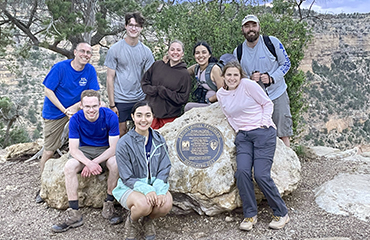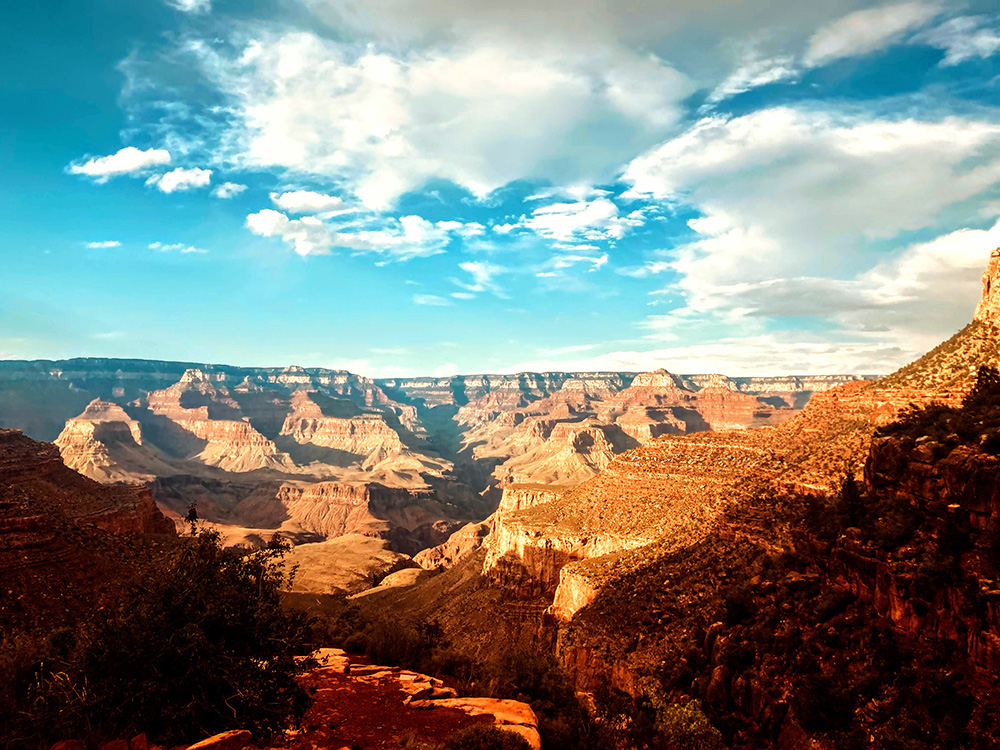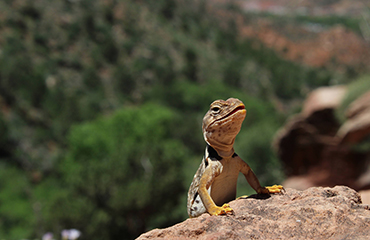
Lander students who recently returned from a study tour to the Grand Canyon and Zion National Park with Professor of English Dr. Sean Barnette went on more than just a hiking trip. In addition to a rim-to-river hike of the canyon (a bucket-list item for many), students used the study tour to closely examine how humans define, interact and discuss “nature.”
“My background is in rhetoric,” Barnette explained, “which is the study of how we use language to get things done. Or, maybe to put it another way, how we create and discover things by using language and symbols.” Before the trip, participants prepped for their adventure not only by meeting for practice hikes, but by reading and thinking about the rhetoric behind “nature.”
On the trip, those discussions about rhetoric translated into questions about our national parks. “Why is this land here in Zion National Park sectioned off as something more significant, whereas the thing right next to it is not ‘nature,’ or is not part of the park?” Barnette asked. “We were asking lots of questions about how our decisions on what to call nature affect the way we interact with nature.” The group also payed close attention to waysides, signs and handouts giving directions and warnings, or advertising different aspects of the National Parks Service, while considering how language shapes our relationship with each park.
 Cultivated Natural Experiences
Cultivated Natural Experiences
To better understand the rhetoric of the National Parks Service, the group met with Dr. Jonathan Shafer, a ranger and public affairs specialist for Zion National Park. Shafer affectionately described the public’s encounters with nature inside Zion as an “illusion.” This characterization gave students a new way to think about their visit to Zion as a cultivated natural experience. “Zion is this beautiful canyon area with mountains on each side and a river flowing through it,” Barnette said. “But because of the work the National Parks Service has done, and others, it’s also an illusion. You’re not actually in wilderness. You’re on a paved walkway, or on an established path.”
Senior mathematics major David Floyd said there were signs that the Grand Canyon was an “illusion,” too, calling attention to the trails they took to Phantom Ranch and back to the top of the south rim. “There is a very beaten path down to the bottom and you can stop at any time to see the grandeur of where you are,” said Floyd. “It was a little scary… the limited sources of water, heat, distance, cliffs and warning signs were intimidating. However, that is as close to wilderness as we could get.”
“The first pioneers to find the canyon,” he added, “didn’t have the path we did.”
These educational opportunities in Zion and the Grand Canyon were paired with an excursion in Las Vegas at the end of the study tour. While there, the group found it easier to spot the things that were human-constructed. “Everything [in Las Vegas] is cultivated,” Barnette said. “There’s an Eiffel Tower there. It’s not the real Eiffel Tower… Everything that is part of the experience that you’re supposed to have is cultivated and artificial in a really self-conscious way.”
But after spending a week looking for the human-made artifacts inside national parks, senior early childhood education major Elizabeth Siversten said she enjoyed the challenge of trying to find evidence of nature inside all the artificiality of Las Vegas. “I think that in Vegas, you have to go looking for the nature,” she said. “You don’t see the canyon walls in Vegas, but I think there are some things that are impacted by nature.” Siversten pointed to the Bellagio Fountains as an example. While they’re completely unnatural, the water they use is a natural resource. And, water scarcity is one of many infrastructure issues Las Vegas faces as a growing metropolitan area.
 The Benefits of Travel as Education
The Benefits of Travel as Education
Developing a deeper appreciation for the language we use to define and interact with the world around us is part of why study tours more broadly are an important part of a liberal arts education. Going outside our natural environment—our comfort zone—forces us to be flexible, to problem solve, to be creative and to learn more about ourselves and what we’re capable of. “Whether it’s a short-term study tour, or a whole semester, or we’ve even had students go away for a year,” Barnette said, “you’re growing in confidence, and flexibility and problem-solving skills. And, these are all things that pay off.”
But study tours are also educational opportunities that invite students to think about what lies ahead for them in their college careers and beyond. This is in line with Lander’s vision statement, which calls for graduates who “are broadly educated, well-informed, equipped for responsible participation in the civic lives of their communities, and prepared to continue their education or launch their careers.” When a student participates in a study tour or a semester studying abroad, they have to apply classroom learning to unique situations that only exist outside the classroom as they navigate new environments, new cultures, and sometimes even new languages. These things only further enhance a student’s Lander University education.
“It’s not perhaps a stereotypical college class that you take anywhere, where you do it, you take the exam, you get the grade and you move on,” Barnette said. “This is something that invited students to think about, ‘Okay, what do I do next?’ I think that sense of drive and excitement is really a valuable piece of travel as education, too.”
Floyd said the friendships formed with other Lander students were another important takeaway. “You sit in a van for six hours on the way to the next national park and you get to know people,” he said. “You make bonds with those around you. Then you hike to the bottom of the Grand Canyon and back up to solidify those bonds. The journey allows you to make friends. The destination allows you to make memories with those friends.”
To learn more about study tour and study abroad opportunities at lander.edu, visit www.lander.edu/studyabroad.